I am overjoyed to announce the launch of Fitz & Follwell’s Flavours of the Main Tour. The tour leaves Chinatown and eats its way up the Main to Jean-Talon Market! It is 5 hours of following in […]

Giving the low-down in Little Italy
I am overjoyed to announce the launch of Fitz & Follwell’s Flavours of the Main Tour. The tour leaves Chinatown and eats its way up the Main to Jean-Talon Market! It is 5 hours of following in the steps of Montreal’s various cultural communities along the Main and tasting their culinary emblems. The tour weaves history, cultural identity and experience with delicious flavours, aromas and the stories that have been cooked up over the last 100 years on the Main!

Our beautiful Jean-Talon Market
If you haven’t heard of Fitz & Follwell, it was originally called Montreal Cycling Tours and has been in operation for almost 4 years. It was founded by young and swinging entrepreneur Shea Mayer. His laid-back cycling tours are the foundation of the company, but the boon of his company has seen the birth of a slick shop at 115 Mount-Royal W., the sale of chic urban bikes, and more recent tours on foot- including Flavours of the Main. Shea also offers snowshoe tours in the winter.
What Shea has going on is great, and I have had the privilege of being aboard this forward-gliding yet un-conventional ship since last November. Shea had the idea of a food tour of the Main with a focus on the cultural communities. He enlisted the help of historian Leah Blythe and through the trick of fate and a little bird named Eric Hanson I was recommended for the gastronomic design.
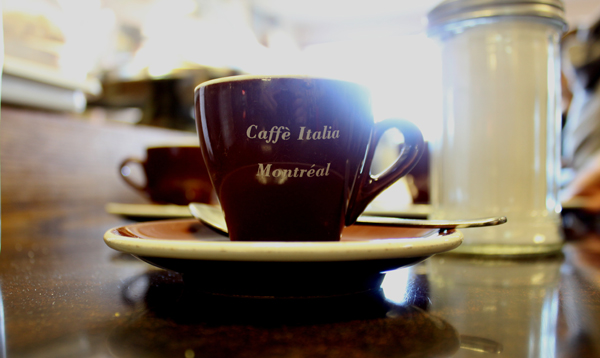
Caffe Italia- historical metting place of lone Italian immigrants
Shea and I plugged through the legal stuff and I attacked a full-time 4 week collection of data, testimony, food-sample cataloguing… and tasting of course! I interviewed some 50 businesses to survey what was feasible, pertinent, and to get a bird’s eye view so we could craft the most delicious tour in terms of food and anecdotes. I taped many of the interviews, typed-out the results, profiled the businesses, collected food history, anecdotes, did research, and visited museum archives. I also spent hours and hours in Nathalie Cooke‘s old Mcgill Institute for the Study of Canada office reading her food history, food theory and gastronomy books to get more tools to use to analyze food and one’s experience of it. Nathalie is now Mc Gill’s associate Provost. I also had great help from Andrée Levesque, a feminist and worker historian who helped me to understand the realities of brothels until the 1930’s in the old Red Light. She also documented “Red on the Main” and introduced me to Eva Circé-Côté who has become an inspiration to me. (I recomend Andrée’s book Eva Circé-Côté: Libre penseuse 1871- 1949.) Velma Candyass and Ethel Bruneau also helped me to get an idea of what the Red Light looked like back in Montréal’s “Las Vegas days,” helping me to visualize the ambiance and different people hard at work there. Susan Semenak, who wrote The Market Chronicles even gave me her favourites and re-iterated the points it is essential to drive home about the street, the Jean-Talon Market and Montreal food.

Café Cleopatra's- Montreal's first modern strip club opened in 1976
I enjoyed the experience more than I can express in words. I met wonderful people that inspired me with their dedication, growth and unwavering passion for what they do. I learned so much, and this was the experience that seemed to be the missing link between my honours degree in Canadian Studies and my DEP in Professional Cooking. The experience also brought me down some emotional alleyways, like the interview with Mr. Chin that does dragon candy, as I’ve known his son Philippe for many years. George, the owner of Wing’s, toured me through Chinatown, describing it in the 1970’s, giving me the in-depth history of Wing’s and Chinatown. Angelo Perusko of Charcuterie Hongrois spent 2 hours telling me how he got from Communist Croatia to where he is now. Elena Faita from Quaincallerie Dante graced me with her philosophy of generosity, diligence and humility and reminded me that “Recessions are a push. You have to push on and innovate and define yourself and take risks. People get discouraged right away and want things to drop in their platter. It doesn’t come on a silver platter.” Sharon Wilensky from Wilensky’s wiped some tears as she spoke of a regular client who had died recently. Irwin Schlafman, owner of Fairmount Bagel let me in on the family history loops that have been repeating…and that he’s a vegan! Frank the general manager of Schwartz’s even took an hour out of his day to give me some juicy melt in your mouth tid-bits and history about Schwartz.

Angelo Perusko- volubile owner of Charcuterie Hongrois
The investigation also reminded me of working at Chinatown Bar during my university party years, working at El Centro Gallego and the Spanish hospitality I have received in the culinary world as well as my long history with the Portuguese, my love for their food, and the love of food of the Italians that I witnessed during my cooking internship in Italy, at St-Pius Culinary institute and in the Italian restaurants I worked in. These communities have directly affected my personal, professional and culinary life over the years.
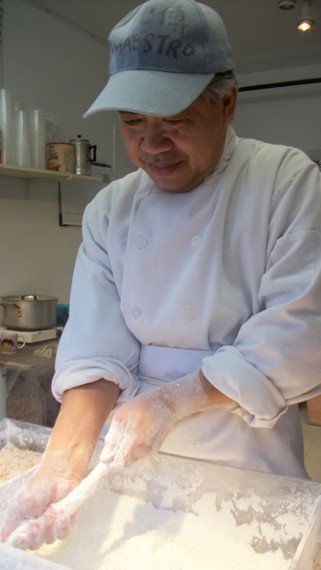
Mr. Chin who makes Dragon's beard candy in Chinatown
I was able to contest to the tightness, simplicity and un-pretentiousness of the food products that have kept people coming back for decades in Montreal. There are so many special things to taste. We really struggled to keep it tight and there were shops that we had to axe.

Cannolis from Alati-Caserta
Leah did wonderful work on the history of the different cultural communities, helping to explain how settlement along the main took place and why people came to Montreal and settled where they did. She painted a great portrait of the lives of different communities at different periods. After blending our efforts, I am very proud to present the results. We have built a great working dynamic of hand feeding hand-picked story, history and food samples. Our styles are complimentary- hers more poised and dealing in larger trends, whereas I help people to get into the microcosm of each shop in an- eh hmmm- intense presentation-style. I am who I am….
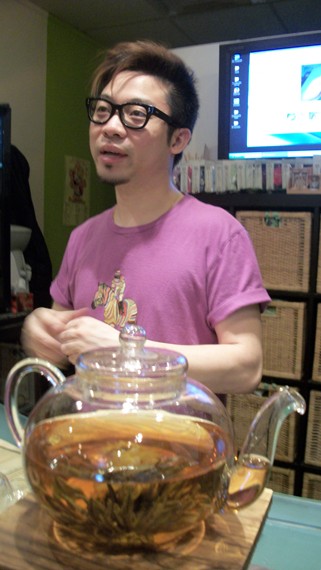
Leo and the blooming tea at My Cup of Tea in Chinatown
Tours are offered 7 days a week. They are $99 and worth every penny. They are a great way for a visitor to see the best food places in Montreal and get a feel for how Montreal has evolved to where it is, but the tour is just as good for the Montrealer who wants to learn about the cultural landscape of their own city and about the people they have been buying food from since they can remember! Come and enjoy an extended lunch of learning, story and local gourmandise! The tour is 5 hours long or it is possible to do two and a half hour tours ($69) or or two two hour and 45 min tours with break in the middle ($119). (There is a discount for people 17 and under.) You will have Leah as a charming historical companion, me as a gastronomic and entrepreneurial companion, or both of us!
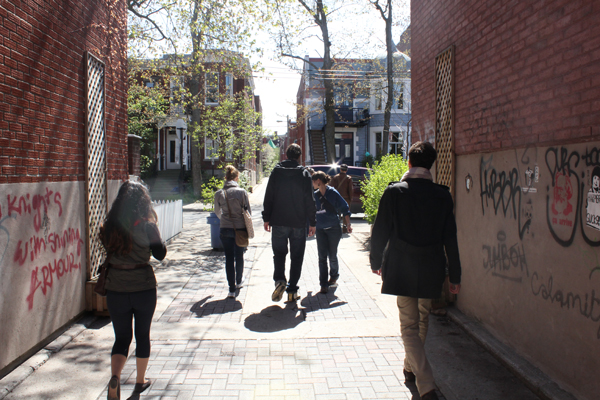
Come visit the main through a different angle: the backways and close-up. It's the Main like you've never seen it.
I went to visit Wing Noodles on the corner of Côté and de la Gauchetière in Chinatown. The machinery was fantastic and I really felt I was in Willy Wong-ka’s factory of magic. I could not photograph the machines, as they did the trickiest parts of the tasks: mixing, rolling and cutting dough. They […]
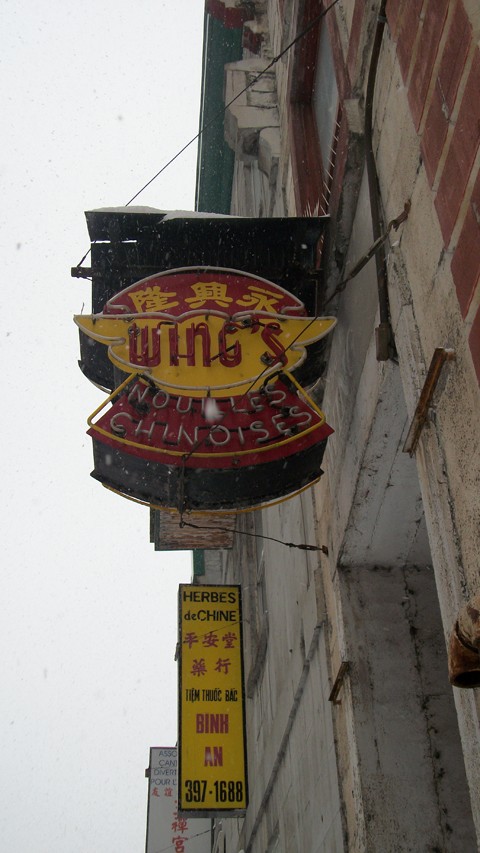
Wing's Sign- Timeless Chinatown
I went to visit Wing Noodles on the corner of Côté and de la Gauchetière in Chinatown. The machinery was fantastic and I really felt I was in Willy Wong-ka’s factory of magic. I could not photograph the machines, as they did the trickiest parts of the tasks: mixing, rolling and cutting dough. They also steamed, baked, fried and cooked. The pump-it-out-o-matic machines work tirelessly, some even with no one next to them monitoring production. It’s as if the factory has a life and rhythm of its own. Little crêpes piped onto a gas oven conveyor belt, are folded while soft, stuffed with a fortune by the machine and sent down into a bin to cool and harden with their proverbial compadres. One far out machine also had a series of six blades that guillotine noodles to standard size one after the other.
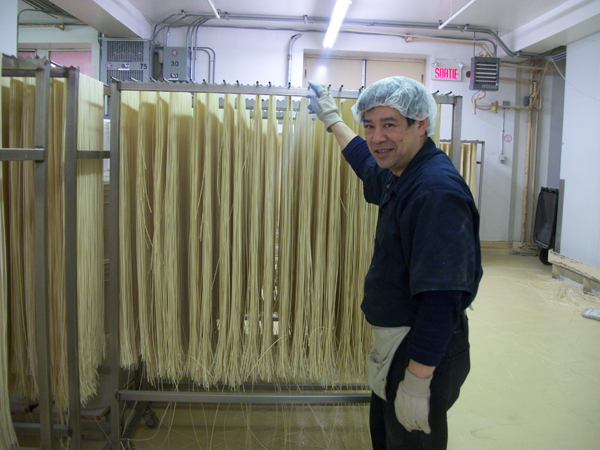
Owner George Lee with noodles being dried and cut
The employees were as cheery as oompa loompa’s whether in delivery, packaging, labelling, measuring into the mixers or in other jobs and departments. There is a real feeling of being part of something magical at Wing’s, and part of a family. The workers are a mix of all nationalities and the owners George and Gilbert work on the floor doing production and then move into offices, over onto the phones, etc. They were present on all levels. Workers help each other and get their foot in the door with common sense, work ethic and punctuality. Most are able to perform two or three different production tasks: to keep them sane and afford Wing’s the versatility of changing production on a dime.
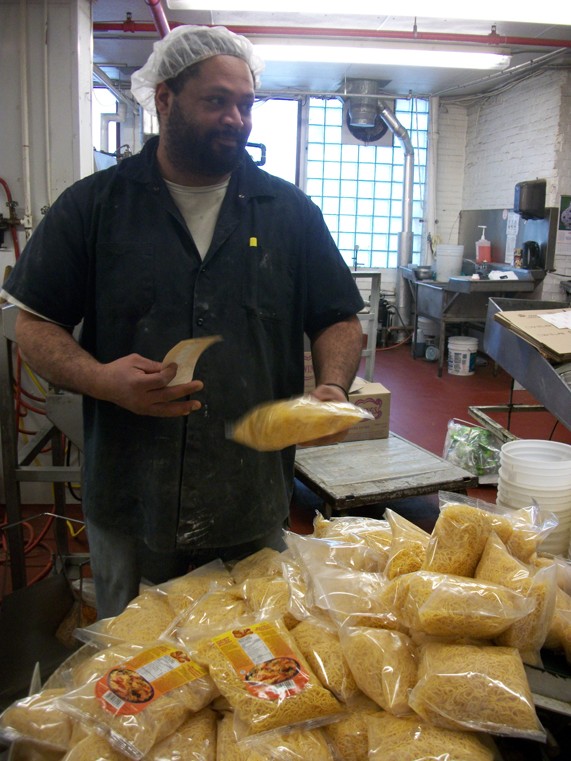
Jeremy Charles- Excellent cook, conaisseur and Martial Artist, the most versatle production employee- and my friend
Wing’s makes everything from Wonton wrappers, egg roll wrappers, pot sticker wrappers, gyoza wrappers, soya sauce, plum sauce, white vinegar packages, almond cookies, fortune cookies, a plethora of noodles including fresh rice noodles made with rice they grind themselves, and a collection of organic noodles. They started making organic noodles about ten years ago and sales are stable, but never took off. Fresh noodle production has been lowered as restaurants are tightening their belts and opting for the cheaper dried noodles with the recession.
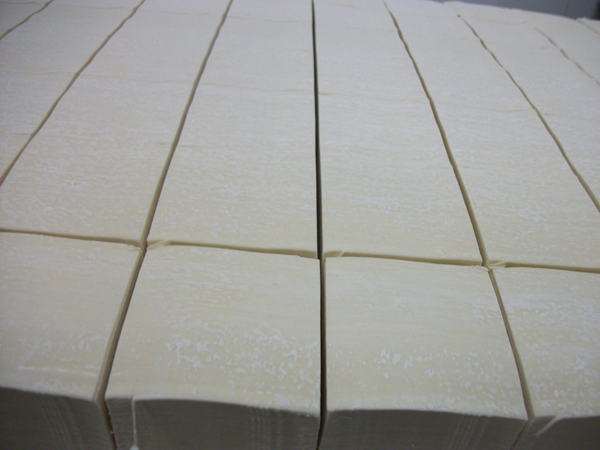
Wonton Wrappers fresh out of the machine
Wing’s fortune cookies are bilingual and they do not include lucky lottery numbers as they do not condone gambling. They made their first batch of cookies specially for a Jewish man that wanted to propose to his wife by having the ring inside in the 60’s. They then decided to start producing them on a large-scale.
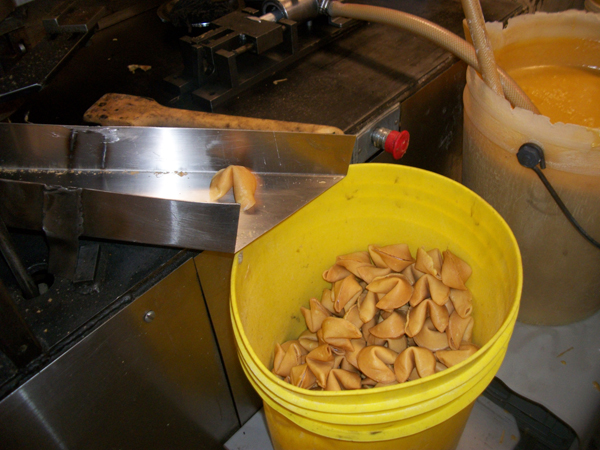
Here comes the fortune cookie out of the machine, still a little warm and soft- The last fortune I got was: "Each moment should be treasured."
Why am I telling you this? Do you care about the industrial production of Chinese food products in Montreal? Maybe you do, or maybe you don’t, but Wing’s itself is important because it is the last-standing original business in Chinatown. Owner George’s Great Grand Father came over to Canada in 1880. It seems he came to work on the last bit of railroad construction. After that, he opened a laundry in St-Jean. This was the typical Chinese trade as it required little language proficiency or start-up costs. His son H.C. Lee worked with him. H.C. started his own laundry/grocery service in Montreal with a cart around the turn of the century, then moved back to China and married there.He came back to Montreal in 1911 and started an import/export service. He and his wife had 6 sons, three of which were university educated. Wing’s as an actual producer of noodles started in the 40’s during the war when noodles could not be imported because of Japanese occupation of China and it was incorporated in 1953. It was taken over by four of H.C.’s sons in the 40’s. The most well-known to the public was philanthropist Arthur Lee.
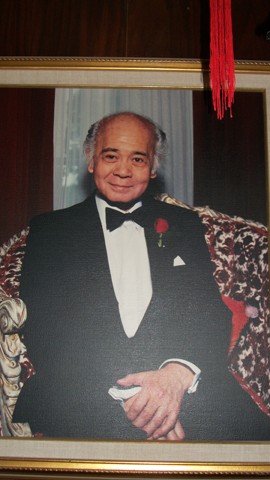
The Portrait of Arthur Lee up in the Office: philanthropist, Businessman and Family Man
The four brothers used their expertise in chemical, mechanical and electrical engineering to come up with or modify existing equipment for noodle and cookie production and refrigeration. (They still have and use the original fridge.) Wing’s already existed under their father, but they brought it up to the level of mass-production. Production has been pondered and tightened on every level.Arthur Lee’s son Gilbert is owner of Wing’s along with his cousin George. George, like his father, prefers to be in the back doing production. The sons of the other brothers opened up their own plants in Toronto and Edmonton. The Wing’s in Toronto is the size of a football field and is the most profitable since most distribution now takes place in Toronto.
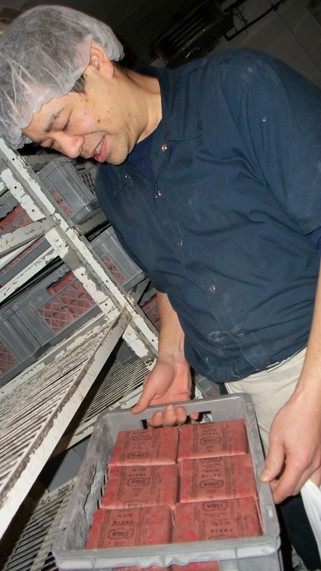
George- Owner and 4th Generation Chinese Canadian and 3rd generation Wing's
Wing’s in Montreal has had to adapt to heavier regulation over time. George says that it would be impossible to start a business the magnitude of Wing’s today with hard-work; the heavy regulation and the city’s outrageous taxes limits opportunities to big investors. George feels for the little guys starting-out because of all of the financial and regulatory obstacles they face. In fact, George says that running a business like Wing’s is a huge endeavour for the profit it generates, but because it is the last-standing original business in Chinatown and they are holding on. They have become a pillar in the Chinese community and they feel they have a social responsibility. Most importantly, they believe in Wing’s.

Wing's- Original Pillar of Chinatown
George walked me through the areas of production and explained the outdoor silos of flour that had programmed amounts of sucked out of them through pipes and sent to the appropriate area. He explained how each product was made, but even more than that he walked me through Chinatown in November to paint a picture of Chinatown in the 70’s when he was a teenager and young adult. Chinatown is now in a great location, but historically it was basically squeezed by the Red Light district to the East and North and the homeless quarter to the South and was the slum where the Chinese were confined. He described the restaurant Ho Ho’s on the South Side of de la Gauchetière between Clark and St-Urbain where you could get Chinese stew, a butter bun and the best Boston Cream Pie for $3.25. People ate along a counter looking out on the street and men mostly did lady-watching. Upstairs was clandestine gambling joints as gambling was even bigger in Chinatown then than now! People lost businesses through gambling. On the east side of St-Laurent were many prostitutes, massage parlours and occasionally people engaging in the transaction of sex for money in the street. The west side was full of Asian variety stores and on the southwest corner of St-Laurent and Réné-Levesque was a cinema where you could see three Kung Fu movies for $3- 6 hours of Kung Fu! St-Laurent and de la Gauchetière was also the home of the Rodeo strip club- pronounced “Lodeo”. Cheap food, gambling, strippers, kung fu cinema- Chinatown’s definitely quieted-down!
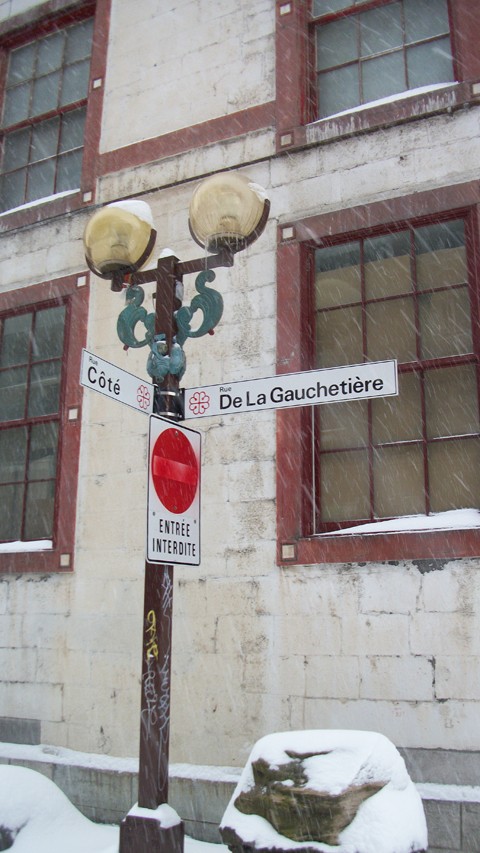
Chinese Streetlamp in the Snow in Montreal
George’s Aunts and Uncles lived in Chinatown and he said there was a real “vie de quartier” or neighbourhood life. People depended on each other and the community was close-knit. The Chinese community had close ties with the Jewish community based on business and the Jewish love of Chinese food. Wing’s helped the huge Wong Wing’s get going as did the owner of Steinburger’s with business advice and encouragement. People moved out through the 70’s and 80’s and the city’s policies and corruption continued to ravage Chinatown until many businesses closed. George says that Chinatown is now a collection of new and disconnected immigrants that only care about making a buck.
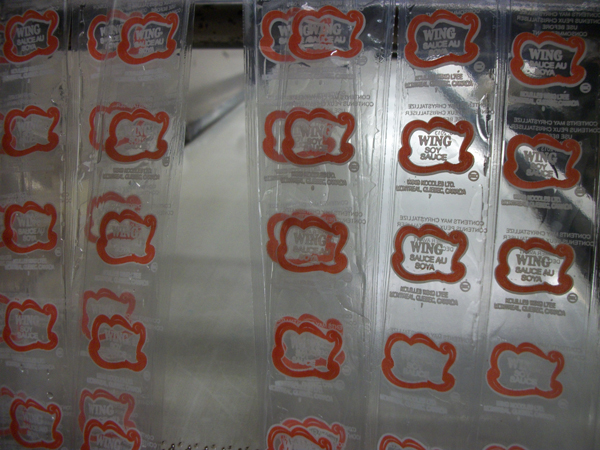
Individual packages waiting to be filled with sauce or vinegar
George recognizes that Wing’s did so well because of the openness and curiosity of the Québecois. It was also built on the many contributions of workers at Wing’s from the Caribbean, Panamanian, Arabs, Greeks and many more. Their first non-Chinese employee from outside of the family, hired in 1961, was a Greek man who worked there for 40 years. George said the hardest phone call he ever made was to call him to tell him that his father Mr Lee had died. This was crazy because he had started out as a grumpy worker and they all called him “Kweilo” or “White Devil”, but he became an integral member of the family over the years.
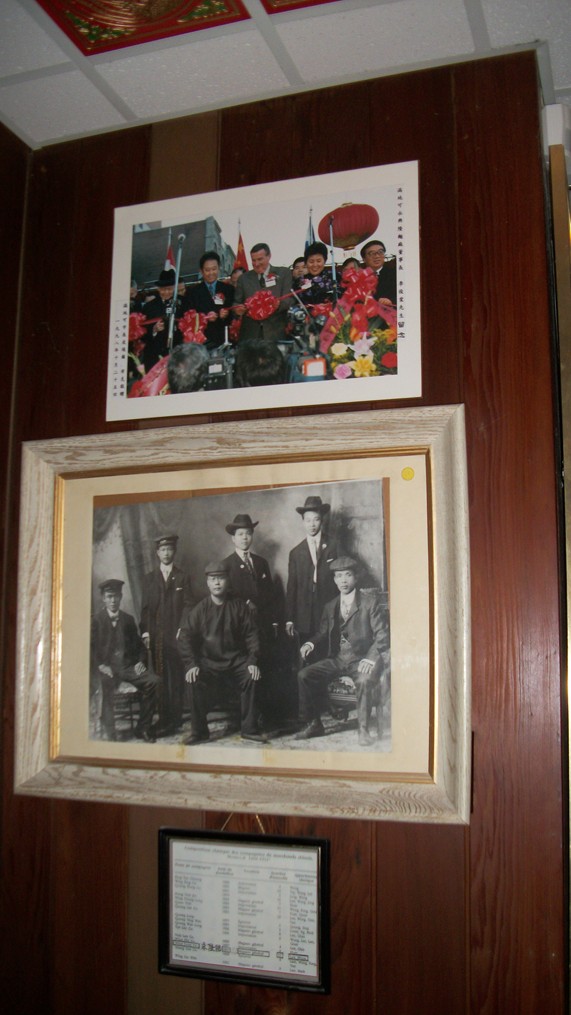
Some of the history on display including family photos with the four Lee sons (and a fifth), and records of Wing's as an importation business
Wing’s is a fantastic mix of technology, secrets, story, family, hard-work, close-ties, innovation, tradition and diversity within Chinese Montreal. Wing’s exemplifies the legacy of a family through the events and tribulations of time. It is a pillar in Chinatown but also a talisman for the entrepreneur, the immigrant, the family, the funky factory and the Montrealer.
Go Check out: Wing’s ad from 1970!
One more intersting thing: for customized fortune cookies for big events please see www.biscuits-fortune-chinois.ca Denis Bordeleau has been making customized fortune cookies with Wing’s help for 20 years! I met him on Fitz & Follwell’s Flavours of the Main tour of which Wing’s is a destination.
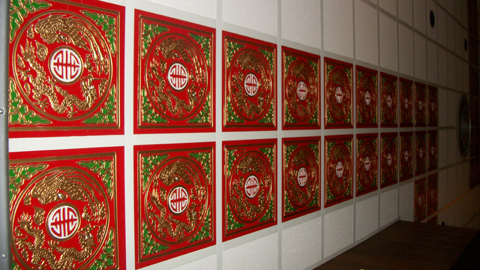
Chinese tiles on the ceiling at Wing's
January 2011 was the 8 year anniversary of the dinner club . We had agreed to do something epic in December 2010: eat in a metro train. On Sunday January 16th, we met at 7:30 pm on the passage over-looking the metro tracks at Côte-Vertu metro. Everyone had backpacks with food, utensils and […]
January 2011 was the 8 year anniversary of the dinner club . We had agreed to do something epic in December 2010: eat in a metro train. On Sunday January 16th, we met at 7:30 pm on the passage over-looking the metro tracks at Côte-Vertu metro. Everyone had backpacks with food, utensils and dishes. Some carried folding chairs, Judith a folding table and I had a table-cloth and adhesive Velcro. As the first members arrived, the anticipation of watching the trains below come and go and waiting for the other members created an electric buzz. By the time I got there, and I was one of the last ones, the buzz was popping out of peoples’ eyes. Voices were shrill yet restrained and giggles were many.
Once all of the illustrious members minus one had arrived, we verified the hour- right on time- and gave the signal- “go, go” . We shuffled down the stairs to the platform over-excited, and whispering. The train was waiting as Cote-Vertu is a terminus. Direction Montmorency- yes, we were riding all the way into that other world of Laval! But which wagon to get into? We consulted in a giddy panic…The second to last. We crashed in and then took stock of the surroundings two blasé solo riders. The beep announcing departure sounded and the doors closed. “Go-go!” We set up a table between the metro seats and some folding chairs. I covered the table with a retro table-cloth and we starts putting velcro on the bottoms of plastic plates and glasses and fastening them to the table-cloth. By the time we had gotten to Namur- we were ready to eat!
The theme of the meal, customized to eating in the metro in January was: food that boosts the immune system. We started with squash soup and banana bread. The first passengers were divided between gaping at us in awe and doing everything to not gape at us in awe, but when we got to Snowdon a lot of people came in. We didn’t expect so many for a Sunday evening. We shared the experience and sheer joy- giving banana bread to the passengers. Downtown we started serving lentil salad and the wagon was packed! People were freaking-out (in a good way): loving the reclaiming of public space, eating the food and taking tons of photos and giving us praise for the bold move. We watched in euphoria citizens with gaping mouths staring at us as we passed through the stations or peoples’ shock when they got in the train and looked up out of their daze to see us.
(Thanks to Eric Hansen for the video montage)
We started serving the meal around Berri: 40 garlic clove chicken and ginger roasted vegetables, accompanied by pungent condiments to ward off the germs: delicious!. After we got through downtown, dinner was quieter and we started to feel at home in our wagon. We ate peacefully- yet always interacting with our surroundings. As we approached Laval, we judged that we wouldn’t have time to eat dessert, so we packed up, got out at Laval and ate dessert on the way back. Dessert was apples stuffed with dried fruit, ginger and spices and baked in a crust and served with spiced apple cider. This was a nice ending. We quietly packed up and got out at Berri to go have a beer and do some kind of de-briefing.
The dinner club’s eight year anniversary was special because we proved you could do dinner club anywhere or anyhow you liked. We had inspired ourselves- we were gutsy, creative and we proved that the barriers that people experience are usually self-imposed or imagined. The passengers were as ecstatic as we were and the only STM employee we saw took a photo of us with his cell phone and gave us a thumbs up.
We shared our way of getting down each month and some of the food that was made with love by our members. We also made the public space one of interaction and expression, for at least that night. The experience got people out of their shells; it got them away from their concentrated floor, wall and book gazing and got them people watching. We also put on display and celebration the bonds we’ve forged through cooking and eating together for eight years.
Topping the eight year anniversary this year is going to be a challenge. If you have any larger than life quirky ideas or themes, please send them in. We are open and willing. The best idea will probably be nested until the ten year anniversary in 2013!
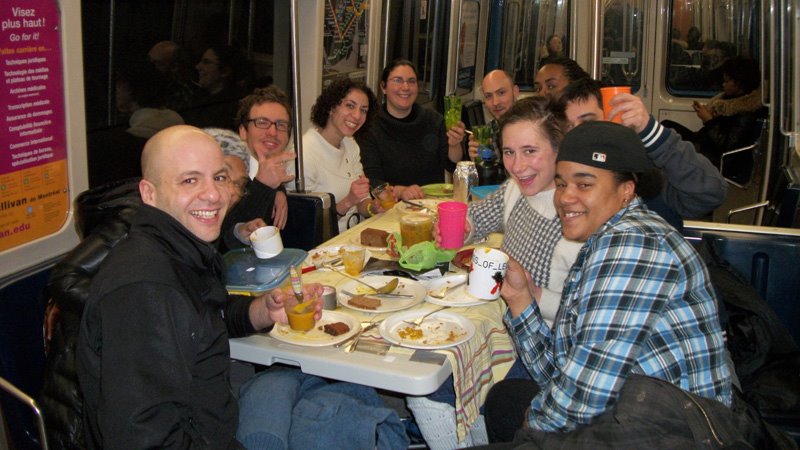
Private Members in the Public Space
CATEGORIES
Archives
- February 2022 (1)
- October 2020 (2)
- September 2020 (1)
- January 2016 (1)
- January 2015 (1)
- October 2014 (1)
- February 2014 (1)
- January 2014 (1)
- July 2013 (1)
- June 2013 (2)
- May 2013 (1)
- March 2013 (1)
- February 2013 (2)
- November 2012 (1)
- September 2012 (1)
- June 2012 (2)
- May 2012 (1)
- April 2012 (1)
- March 2012 (1)
- February 2012 (1)
- January 2012 (2)
- December 2011 (1)
- November 2011 (4)
- October 2011 (4)
Popular Tags
'Round Table Tours Asian breakfast business prolfiles cabbage canning Community Europe Events farms fermentation Fitz & Follwell Food & Story Food history Food Production food tours fresh juices Friends gastronomy health herbs History Italy kimchi Meal exchange Nuart organic preserves public Quebec restaurant Rumble & Shakes Réseau d`Entraide de Verdun salt smoothies spicy Tours de la Table Vegan youtube videos

